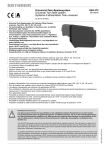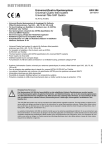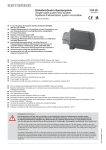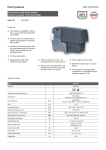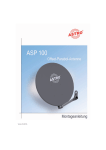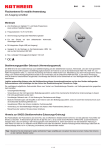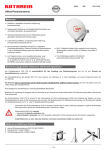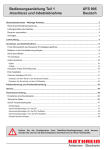Download Kathrein UAS 585
Transcript
Universal-Quatro-Speisesystem, schaltbar UAS 585 20110020 Universal Quatro feed system, switchable Système d’alimentation Quatro universel, commutable 10,70-12,75 GHz • Universal-Quatro-Speisesystem (schaltbar) für Kathrein-OffsetParabolantennen, Typ CAS .. (60, 75, 90, 120 cm Ø) • Für den Empfang von Satelliten im Ku-Band, wie z. B. ASTRA, EUTELSAT oder TürkSat • Das Speisesystem entspricht der ASTRA-Spezifikation • Universal-Speisesystem für Gemeinschaftsanlagen mit 2 Polarisationen und 2 Frequenzbereichen (Low- u. High-Band bzw. Analog u. Digital) für 4 Anschlüsse ohne zusätzliche Matrix • Für lineare Polarisation • Unabhängige Wahlmöglichkeit horiz./vert., Low-/High-Band von jedem Receiver aus • Umschaltung horiz../vert., Low-/High-Band über das Koaxialkabel durch 14/18 V und 22 kHz • Mit Matrizen (z. B. EXR 1516) erweiterungsfähig bis zu 16 Anschlüssen • Stromversorgung erfolgt über Niederführungskabel • Multifeed-tauglich durch kompakten Aufbau • Komplettschutz von LNB und Kabelanschlüssen im belüfteten Gehäuse, Schutzart: IP 54 • • • • • • • • • • • • • • • • • • Universal Quatro feed system (switchable) for Kathrein offset parabolic antennas, type CAS.. (60, 75, 90, 120 cm Ø) For reception of satellites in the Ku band, such as ASTRA, EUTELSAT and TürkSat The feed system complies with ASTRA specifications Universal feed systems with 2 polarisations and 2 frequency ranges (low and high band or analogue and digital) for 4 connections without an additional matrix For linear polarisation. Option to select horiz./vert., low band/high band independently from each receiver Switch-over horiz./vert., low band/high band via the coaxial cable through 14/18 V and 22 kHz Extendable to up to 16 subscriber connections using matrices (e.g. EXR 1516) Power supply via drop cable Multifeed-suitable due to compact design Full protection of LNB and cable connections in a ventilated housing, protection category IP 54 Système d’alimentation Quatro universel (commutable) pour antennes paraboliques offset Kathrein type CAS.. (60, 75, 90, 120 cm Ø) Pour la réception des satellites dans la bande Ku, comme ASTRA, EUTELSAT ou TürkSat. Le système d’alimentation est conforme à la spécification ASTRA pour les systèmes d’alimentation universels Pour installations collectives avec deux polarisations et deux gammes de fréquences (bande basse/haute ou analogique/numérique) pour 4 raccordements sans matrice supplémentaire Pour polarisation linéaire Possibilité de sélection indépendante horizontale/verticale, bande basse/haute depuis chaque récepteur Sélection indépendante hor./vert., bande haute/bande basse par 14/18 V et 22 kHz via le câble coaxial Extensible jusqu’à 16 raccordements en utilisant des matrices (par example EXR 1516) Alimentation électrique par câble descendant Possibilité de réception Multifeed grâce à la compacité du système Protection complète du LNB et des branchements dans un boîtier ventilé du type de protection : IP 54 Hinweise/Notes/Remarques Das Speisesystem UAS 585 darf ausschließlich an die aufgeführten Kathrein-Parabolantennen montiert werden. Für das Speisesystem gelten die gleichen Sicherheits- und Gefahrenhinweise, wie sie in den Anwendungshinweisen der Offset-Parabolantennen aufgeführt sind. Bitte beachten Sie unbedingt diese Hinweise, da sonst Gefahren für Sie oder Ihre Mitmenschen auftreten können (Stromschlag durch Freileitungen, Absturzgefahr, herabfallende Teile, Gewitter etc.) The UAS 585 feed system may only be mounted to the listed Kathrein parabolic antennas. The feed system is subject to the same safety and danger warnings as listed in the instructions for using offset parabolic antennas. Please follow these instructions at all times, as otherwise you or other people may be exposed to danger (electric shock through overhead lines, risk of falling down, falling parts, thunderstorm etc.) Le système d’alimentation UAS 585 ne doit être monté que sur les antennes paraboliques Kathrein. En ce qui concerne le système d’alimentation, les instructions de danger et de sécurité appliquées sont identiques à celles décrites dans les instructions d’utilisation desantennes paraboliques Offset.Veuillez suivre scrupuleusement ces instructions, sinon vous risqueriez de vous mettre vous-même en danger ou d‘autres personnes (décharge électrique due à des câbles aériens, risque de chute, pièces risquant de se détacher, orage etc.) 936.3191/B/1008/1.8d/e/f • • • • Technische Daten/Technical data/Données techniques Typ/Type/Modèle UAS 585 Bestell-Nr./Order no./Référence 20110020 Geeignet für Parabolspiegel Suitable for parabolic antennas Convient pour antenne parabolique CAS 06, 60, 075, 75, 75/R, 09, 90, 90/R, 120 Umschaltbar: vertikal (14 V)/horizontal (18 V) Switchable: vertical (14 V)/horizontal (18 V) Commutable: vertical (14 V)/horizontal (18 V) Eingangsfrequenz Input frequency Fréquence d’entrée Verstärkung Gain Gain Ausgangsfrequenz Output frequency Fréquence sortie Oszillatorfrequenz (L.O.) Oscillator frequency (L.O.) Fréquence d’oscillateur (L.O.) Phasenrauschen Phase noise Bruit de phase GHz Umschaltbar: 10,70-11,70 GHz (0 kHz); 11,70-12,75 GHz (22 kHz) Switchable: 10.70-11.70 GHz (0 kHz); 11.70-12.75 GHz (22 kHz) Commutable: 10,70-11,70 GHz (0 kHz); 11,70-12,75 GHz (22 kHz) dB > 50 MHz 950-1950/1100-2150 GHz 9,75/10,60 dBc 1 kHz < -60, 10 kHz < -80, 100 kHz < -85 Systemgüte (G/T) (bei 11,3/12,5 GHz) System figure of merit (G/T) (at 11,3/12,5 GHz) Facteur de qualité du système (G/T) (à 11,3/12,5 GHz) Polarisationsentkopplung Polarisation decoupling Découplage de polarisation Ausgang/Impedanz Output/impedance Sortie/impédance Versorgungsspannung LNB Supply voltage LNB Tension d’alimentation LNB Stromaufnahme LNB Current drain LNB Consommation de courant LNB Abmessungen Dimensions Dimensions Verpackungs-Maße Packing dimensions Dimensions de l’emballage Gewicht ca. Approx. weight Poids env. Mit With Avec CAS 06, 60: CAS 075, 75, 75/R: CAS 09, 90, 90/R: CAS 120: dB Typ. 25 Ω 4 x F-Connector/75 V 14,7/15,7 dB/K 17,2/18,2 dB/K 18,8/19,8 dB/K 22,0/23,0 dB/K Betrieb mit Matrix Operation with matrix Service avec matrix horiz./low: 15,5–19 V (Ausgang 1/ output 1/ sortie 1) Alle anderen 0 V all others 0 V/tous les autres 0 V Schaltbetrieb Switched mode Service de commutation vert.: 11,5–14,8 horiz.: 15,5–19 V mA Typ. 200 mm 235 x 135 x 44 mm 295 x 185 x 65 kg 0,8 936.3191/B/1008/2.8def Polarisation Speisesystem-Montage (Abb. 1) Mounting the feed system (Fig. 1) Montage de la système d´alimentation (Fig. 1) Hier ansetzen Insert here Introduire ici Das Speisesystem an gewünschter Position auf die MultifeedPlatte am Tragarmende aufsetzen (siehe Anwendungs-hinweis Antenne) und durch Anziehen (Anzugsdrehmoment: 4,5 Nm) der Innensechskantschraube im vorderen Bereich befestigen. Alle Befestigungs- und Einstelloperationen können mit dem beigelegten Innensechskantschlüssel (SW4) vorgenommen werden. Position the feed system as desired on the multifeed plate at the end of the bracket (see antenna instructions) and fasten on the front part using the Allen wrench (torque: 4.5 Nm) . All fastening and tightening can be effected with the supplied Allen wrench (SW4). Placer le système d’alimentation à la position souhaitée sur la plaque Multifeed à l’extrémité du bras support (voir les instructions d’utilisation de l’antenne) et le fixer en serrant (couple de serrage : 4,5 Nm) la vis à six pans creux à l’avant. Toutes les opérations de fixation et de réglage peuvent être effectuées à l’aide de la clé de 4 jointe. MA= 4,5 Nm Abb. 1/Fig. 1 Polarisations-Voreinstellung (Abb. 2) Wert für die Polarisations-Voreinstellung aus Tabelle Seite 7 entnehmen. Bei abweichendem Wert von den voreingestellten 0° ist wie folgt zu verfahren: 1. Beide Innensechskantschrauben (S) lockern 2. Durch Drehen des Speisesystems die Referenzmarke auf den Wert lt. Polarisations-Voreinstellungs-Tabelle einstellen (siehe Abb. 2) 3. Die Innensechskantschrauben (S) gleichmäßig im Wechsel festziehen. Anzugsdrehmoment: Max. 4,5 Nm InnensechskantSchraube (S) Allen screw Vis à six pans Polarisation +15° Setting the polarisation (Fig. 2) See the value in the table on page 7 for the polarisation setting. If the value differs from the pre-set 0°, proceed as follows: 1. Loosen both Allen screws (S). 2. Turn the feed system to set the reference mark to the value given in the polarisation pre-setting table. (see fig. 2) 3. Tighten the Allen screws (S) evenly, alternating between both. Torque: max. 4.5 Nm Polarisation 0° Relever la valeur d’ajustage de polarisation du tableau en page 7. Au cas où la valeur est différente de la valeur préajustée de 0°,procéder comme suit: 1. Desserrer les deux vis à six pans creux (S). 2. Tourner le système d’alimentation pour régler le repère de référence sur la valeur indiquée dans le tableau de préréglage de la polarisation (voir la fig. 2) 3. Serrer les vis à six pans creux (S) de manière homogène en alternance. Couple de serrage : maxi. 4,5 Nm Polarisation -15° Abb. 2/Fig. 2 9936.3191/B/1008/3.8def Ajustage de la polarisation (Fig. 2) Kabelanschluss (Abb. 3) 1. Innensechskantschraube (S) am hinteren Ende der Haube lösen, bis die Haube durch leichten Druck nach unten ausrastet und abgenommen werden kann . InnensechskantSchraube (S) Allen screw Vis à six pans Hinweis: Wird nicht nur das Speisesystem ausgetauscht, sondern eine Neuinstallation der Antenne vorgenommen, fahren Sie zuerst mit dem Punkt „Ausrichten der Satelliten-Empfangsanlage“ fort und kehren im Anschluss zum Punkt „Kabelanschluss“ zurück. 2. Beiliegende F-Stecker auf Kathrein-Kabeltyp LCD 95, 99 oder 111 montieren (siehe Abbildung) und an das LNB anschließen. 3. Beim Betrieb mit einer nachgeschalteten Matrix auf die korrekte Ausgangsbelegung achten (Versorgungsspannung nur über LNB-Ausgang 1). 4. Angeschlossene Kabel nach vorne führen und seitlich in den Kabelhalter (siehe Vergrößerung in Abb. 3 unten) eindrücken. 5. Haube aufschieben bis sie in die Nut eintaucht und im unteren Bereich einrastet. Innensechskantschraube (S) festziehen. Cable connection (Fig. 3) 1. Loosen the Allen screw (S) at the rear end of the cover until the cover can be unlocked by applying light downward pressure; remove cover. Note: If the feed system is not only exchanged but a new antenna system is being installed, proceed first as described in the section “Aligning the satellite reception system” and then return to “Cable connection”. 2. Mount the supplied F-type plug onto the Kathrein cable types LCD 95, 99 or 111 (see figure) and connect to the LNB. 3. When operating with a downstream matrix, make sure the correct output is assigned (supply voltage only through LNB output 1). 4. Lead the connected cable forwards and insert sideways into the cable fastening (see close-up in fig. 3 below). 5. Slide on the cover until it fits into the groove and locks in the bottom section. Tighten Allen screw (S). Raccordement de câbles (Fig. 3) 1. Desserrer la vis à six pans creux (S) à l’extrémité arrière du capot jusqu’à ce que celui-ci puisse être déverrouillé d’une légère pression vers le bas et retiré. 2. Monter les connecteurs F joints sur le câble Kathrein type LCD 95, 99 ou 111 (voir la figure) et les raccorder au LNB. 3. En cas d’utilisation avec une matrice en aval, s’assurer de la bonne correspondance des sorties (tension d’alimentation uniquement par la sortie LNB 1). 4. Amener les câbles raccordés vers l’avant et les enfoncer latéralement dans le support de câbles (voir l’agrandissement au bas de la fig. 3). 5. Mettre en place le capot qui doit entrer dans la gorge et s’enclencher au bas. Serrer la vis à six pans creux (S). Abb. 3/Fig. 3 936.3191/B/1008/4.8def Remarque: Si le système d’alimentation est remplacé et qu’une nouvelle installation de l’antenne est effectuée, poursuivez d’abord par le point «Orientation de l’antenne satellite » puis revenez au point « Branchement des câbles ». Ausrichten der Satelliten-Empfangsanlage (Abb. 4) Hinweis: Wird lediglich das Speisesystem ausgetauscht, kann das Ausrichten der Antenne entfallen. 1. Grundeinstellung nach beiliegender Azimut-/Elevationstabelle vornehmen. 2. Durch Drehen über die Azimut-Achse Sender suchen (siehe beiliegende Azimut-/Elevationstabelle) und auf Maximalanzeige einstellen (bei Verwendung eines KathreinSatelliten-Messempfängers MSK ...). Steht kein Messgerät zur Verfügung, auf beste Bildqualität einstellen (siehe Abb. 5 und Text). 3. Elevation auf Maximalanzeige bzw. beste Bildqualität einstellen. 4. Azimut-Einstellung überprüfen und gegebenenfalls nachjustieren. 5. Alle Befestigungsteile auf vorgeschriebenes Drehmoment MA festdrehen (siehe Montageanleitung der Parabolantenne). 6. Fahren Sie mit dem Punkt “Kabelanschluss, (Aufzählungspunkt 2)” fort. Azimut Azimut Elevation Aligning the satellite reception system (Fig. 4) Note: If the feed system is only to be exchanged, the antenna does not have to be aligned. Elevation 1. Align according to enclosed azimuth/elevation table. 2. Tune to wanted programme (see enclosed azimuth/elevations table) by turning the antenne around the azimuth axle until max. signal level is obtained (if a Kathrein signal meter MSK.. is used), or until best picture quality is reached (without signal meter) (see Fig. 5). 3. Adjust elevation until max. signal level or best picture quality are obtained. 4. Check azimuth adjustment and correct if neccessary. 5. Firmly fix all bolts to advised torque moment MA (see mounting instructions for parabolic antenna). 6. Continue as described in section “Cable connection” (item 2). Positionnement de l’antenne satellite (Fig. 4) Remarque: Si seul le système d‘alimentation est remplacé, l‘orientation de l‘antenne est inutile. Abb. 4/Fig. 4 936.3191/B/1008/5.8def 1. Procéder à l’alignement de l’antenne selon le tableau Azimut/ Elevation livré avec la tête. 2. Rechercher un programme satellite (voir tableau azimut/élévation livré avec la tête) en tournant l’antenne autour de son axe Azimut jusqu’on a trouvé le niveau le plus élévé (en cas d’utilisation d’un mesureur de champ satellite Kathrein (MSK..) ou jusqu’à l’on a obtenu la meilleure image (alignement sans mesureur de champ satellite) (voir Illustr. 5). 3. Ajuster maintenant l’élévation à l’aide du niveau le plus élévé ou de la meilleure image. 4. Contrôler à nouveau l’ajustage Azimut et réajuster si nécessaire. 5. Serrer tous les éléments de fixation conforme au moment de torque MA prescrit (voir avis de montage pour l’antenne parabolique). 6. Poursuivez avec le point « Branchement des câbles » (point 2 de l’énumération) Da die Antennenkeule im Bereich des Maximums nur leicht gekrümmt ist, ist bei Ausrichtung in diesem Bereich eine gute Bildqualität zu erwarten. Jedoch kann es aber sein, dass die Antenne links oder rechts „gerade noch“ auf diesen guten Empfangsbereich ausgerichtet ist. Schon bei den ersten Schwankungen des Antennen-Standrohres kann die vermeintlich gute Bildqualität über die steilen Keulenflanken abstürzen. Um dies zu vermeiden, sollte die Empfangsanlage auf Mitte des Pegelmaximums eingestellt werden. Zur Einstellung mit Hilfe eines Kathrein-Satelliten-Messempfängers, wie z. B. MSK 15 oder MSK 200, gehen Sie wie folgt vor: 1 Mitte der Mastschelle markieren 2 Antenne nach links drehen, bis ein Pegelabfall von z. B. 8 dB (oder Spikes) auftritt. Mastschellen-Markierung auf den Mast übertragen 3 Antenne nach rechts drehen, bis ein Pegelabfall von 8 dB auftritt. Mastschellen-Markierung auf den Mast übertragen 4 Dann Mastschellen-Markierung genau in die Mitte der Mastmarkierungen stellen. So wird die bestmögliche Empfangssituation erreicht Für die Elevations-Optimierung ist ebenso zu verfahren. As the antenna lobe in the maximum range is only slightly curved, an excellent picture quality can be expected when it is aligned to this range. However, it may also be that the antenna at the left or right is “only just” aligned to this excellent reception range. As soon as the antenna stanchion experiences any vibration the supposed excellent picture quality can drop off at the steep edge of the lobe. To avoid this, the reception position should be set to the middle of the maximum level. Proceed as follows when conducting the setting-up process using a Kathrein test receiver such as MSK 15 or MSK 200: 1 Mark the centre of the mast clamp 2 Turn the antenna to the left until the level drops by, e.g. 8 dB (or spikes occur). Transfer the mast clamp marking to the mast 3 Turn antenna to the right until the level drops by 8 dB. Transfer the mast clamp marking to the mast. 4 Position the mast clamp marking in the exact centre of the mast markings. This will ensure that an ideal reception situation is given Proceed in a similar manner to optimise the elevation. Abb./Fig.5 Pour éviter ceci, l’installation de réception doit être réglée sur le milieu du maximum du niveau. Pour le réglage à l’aide d’un récepteur de mesure satellite Kathrein, tel que MSK 15 ou MSK 200, procéder comme suit : 1 Marquer le milieu de la cheville du mât 2 Pivoter l’antenne vers la gauche, jusqu’à ce qu’une chute de niveau par ex. de 8 dB (ou spikes) intervienne. Reporter la marque de la cheville du mât sur le mât 3 Pivoter l’antenne vers la droite, jusqu’à ce qu’une chute du niveau de 8 dB intervienne. Reporter la marque de la cheville du mât sur le mât. 4 Puis placer la marque de collier du mât exactement au milieu des marques du mât. De cette façon la meilleure position possible de réception est obtenue Pour optimiser l’élévation, procéder de la même façon. 936.3191/B/1008/6.8def Etant donné que le lobe de rayonnement de l’antenne n’est que légèrement incliné au niveau du maximum, la qualité de l’image devrait être satisfaisante. Il se peut pourtant que l’antenne à gauche ou à droite se trouve « tout juste encore » orientée sur cette réception. Dès les premières oscillations du tube de positionnement de l’antenne, ladite bonne qualité de l’image peut chuter sur les flancs abrupts du lobe de rayonnement. -21 -18 -24 Serbien-Montenegro/Serbia and Montenegro/Serbie-Monténégro Slowakei/Slovakia/Slovaquie Slowenien/Slovenia/Slovénie -1 -4 -24 -5 0 -1 -11 1 4 -28 2 7 4 -17 3 7 9 -3 6 13 -22 7 2 6 -4 -5 -4 -2 4 -12 -1 -8 14 10 -9 0 2 14 -5 8 ASTRA 19.2° Ost East/Est 3 0 -21 -1 3 5 -7 1 9 -26 2 -2 1 -8 -9 -8 -6 1 -17 -4 -13 11 5 -13 -4 -3 10 -9 5 EUTELSAT W2 16° Ost East/Est 6 2 -18 2 6 8 -5 2 11 -23 5 0 2 -6 -6 -6 -3 4 -15 -1 -11 14 6 -10 -2 -1 13 -7 8 HOTBIRD 13° Ost East/Est 9 5 -15 5 8 11 -2 4 14 -20 7 3 4 -4 -3 -3 0 7 -13 3 -9 18 7 -7 0 1 16 -5 11 EUTELSAT W1 10° Ost East/Est 11 7 -11 8 11 14 1 5 17 -17 9 6 5 -1 0 -1 2 10 -11 6 -7 21 9 -5 3 3 19 -2 15 EUTELSAT W3A 7° Ost East/Est 18 13 -2 15 17 21 8 9 23 -8 15 13 9 5 9 6 10 17 -6 15 -2 28 12 3 9 8 25 4 22 Thor 2/3 0.8° West West/Ouest 21 16 3 18 20 24 12 11 26 -3 18 16 10 8 13 9 13 20 -3 19 1 32 14 7 12 11 29 8 26 Atlantic Bird 3 5° West West/Ouest ´23/11 ´19/7 ´6/5 ´21/9 ´22/10 26/14 ´15/§ ´13/1 28/16 0/-12 ´20/8 ´18/6 12/0 10/-2 ´16/4 12/0 `16/4 ´23/11 0/12 ´22/10 3/-9 34/22 15´/3 10/-2 14´/2 ´13/1 31/19 10/-2 28/16 Atlantic Bird 2/ Telecom 2D 8° West West/Ouest 35 31 29 34 34 39 30 21 38 24 31 32 19 24 32 26 31 36 15 37 17 46 21 27 28 24 41 25 41 Hispasat 1C/1D 30° West West/Ouest 936.3191/B/1008/7.8def Trouvez d´autres pays ou villes sur notre page dans l´internet: www.kathrein.de/en/sat/index.htm dans le point de menu “satellite reception systems/technical information/azimut/elevation and polarisation-presetting“. Find more countries or cities on the Kathrein website on the Internet: www.kathrein.de/en/sat/index.htm, under: “satellite receiption systems/technical information/azimut/elevation and polarisation-presetting“. Weitere Länder bzw. Städte in diesen Ländern finden Sie im Internet auf der Kathrein-Homepage unter „www.kathrein.de/de/sat/index.htm“ im Menüpunkt „Satelliten-Empfangsanlagen/Technische Infos/Azimut/Elevation und Polarisations-Voreinstellung“. -20 -28 Schweiz/Switzerland/Suisse Ungarn/Hungary/La Hongrie -12 Schweden/Sweden/Suède -40 -16 Rumänien/Romania/Roumanie -21 -43 Tschechien/Czech Republic/Republique Tchéque 0 -17 Polen/Poland/Pologne Portugal/Portugal/Portugal Spanien/Spain/L´Espagne -6 -11 -24 Österreich/Austria/L´Autriche -10 -13 -11 -10 -5 -17 Norwegen/Norway/Norvège Irland/Ireland/L´Irlande -10 -13 -25 -30 Italien/Italy/L´Italie Niederlande/Netherlands/Les Pays-Bas -29 Großbritannien/Great Britain/La Grande-Bretagne 2 -31 -26 Griechenland/Greece/Grèce 6 -26 -21 Finnland/Finland/Finlande -16 Monaco/Monaco/Monaco -7 Frankreich/France/France -7 -4 Luxemburg/Luxemburg/Luxembourg -32 Deutschland/Germany/Allemagne -24 -23 Dänemark/Denmark/Danemark 4 -26 -19 Bulgarien/Bulgaria/Bulgarie -2 -11 Liechtenstein/Liechtenstein/Liechtenstein -17 Belgien/Belgium/La Belgique ASTRA (Eurobird 1) 28.2° Ost East/Est Kroatien/Croatia/Croatie -23 -27 Albanien/Albania/L´Albanie Land/Country/Pays TÜRKSAT 42° Ost East/Est Satelliten/Satellites/Satellites Préréglage de polarisation pour des systèmes d‘alimentation compacts dans des pays européens differents (le milieu géographique de chaque pays est le point de référence respectif) Si le préréglage de polarisation est plus de ± 25°, le système doit être réglé à la butée respective Polarisation-presettings for compact feed systems in various European countries (the geographical centre of each country is the point of reference in each case) In case of polarisation-presettings exceeding ± 25°, the feed system is to be set to the respective stop. Polarisations-Voreinstellungen für Compact-Speisesysteme in verschiedenen europäischen Ländern (Bezugspunkt ist jeweils die geografische Mitte des Landes). Bei Polarisations-Voreinstellungen größer als ± 25° ist das Speisesystem auf den jeweiligen Anschlag einzustellen. Polarisations-Voreinstellungen in verschiedenen Ländern für Compact-Speisesysteme Pre-setting the polarisation for compact feed systems in various countries Présélection de la polarisation des systèmes d‘alimentation compacts pour différents pays Anwendungsbeispiele (Abb. 6-7) Application examples (Fig. 6-7) Exemples d´application (Fig. 6-7) UAS 585 Schaltbetrieb mit bis zu 4 Teilnehmern Switched mode operation for up to 4 subscribers Service de commutation pour jusqu’à 4 abonnés low 1 H low / high H/V high 2 4 connections without additional multi-switches Nr.: 1682964 Sat ZF / MHz 950 - 1950 (low) 1100 - 2150 (high) f/GHz 10.7 - 12.75 4 Anschlüsse ohne zusätzliche Matrix low 3 V low / high H/V high 4 Abb./Fig.6 4 raccordements sans commutateurs multiples supplémentaire low 1 H low / high H/V high 2 Nr.: 1682964 f/GHz 10.7 - 12.75 Sat ZF / MHz 950 - 1950 (low) 1100 - 2150 (high) low 3 V low / high H/V high 4 Abb./Fig.7 Hinweis/Note/Remarque: Zuordnung der Ein- bzw. Ausgänge von LNB und Multischalter unbedingt einhalten. The assignment of LNB and multi-switches in- and outputs must be observed without fail. Il faut respecter l‘allocation des entrées et sorties du LNB et de la commutateurs multiples. Elektronische Geräte gehören nicht in den Hausmüll, sondern müssen - gemäß Richtlinie 2002/96/EG DES EUROPÄISCHEN PARLAMENTS UND DES RATES vom 27. Januar 2003 über Elektro- und Elektronik-Altgeräte fachgerecht entsorgt werden. Bitte geben Sie dieses Gerät am Ende seiner Verwendung zur Entsorgung an den dafür vorgesehenen öffentlichen Sammelstellen ab. Electronic equipment is not household waste - in accordance with directive 2002/96/EC OF THE EUROPEAN PARLIAMENT AND THE COUNCIL of 27th January 2003 on used electrical and electronic equipment, it must be disposed of properly. At the end of its service life, take this unit for disposal at a relevant official collection point. Les appareils électroniques ne doivent pas être mis dans la poubelle de la maison, mais doivent être recyclés correctement selon la directive 2002/96/EG DU PARLEMENT ET DU CONSEIL EUROPEEN du 27 janvier 2003 concernant les appareils électroniques et électriques usagés. Nous vous prions de mettre cet appareil à la fin de son utilisation dans un emplacement prévu pour son recyclage. Internet: http://www.kathrein.de KATHREIN-Werke KG . Anton-Kathrein-Straße 1 – 3 . Postfach 10 04 44 . D-83004 Rosenheim . Deutschland . Telefon (0 80 31) 1 84-0 . Fax (0 80 31) 1 84-3 06 936.3191/B/1008/8.8def UAS 585 Technische Änderungen vorbehalten/Subject to technical changes/Nous nous réservons le droit de toutes modifications techniques Erweiterung auf mehr als 4 Teilnehmer mit Sat-ZF-Verteilsystem-Multischalter Extension to more than 4 subscribers with Sat-IF distribution multi-switches. Extension à plus de 4 abonnés en utilisant des commutateurs multiples pour système de distribution satellite FI.
This document in other languages
- français: Kathrein 20110020
- Deutsch: Kathrein 20110020








